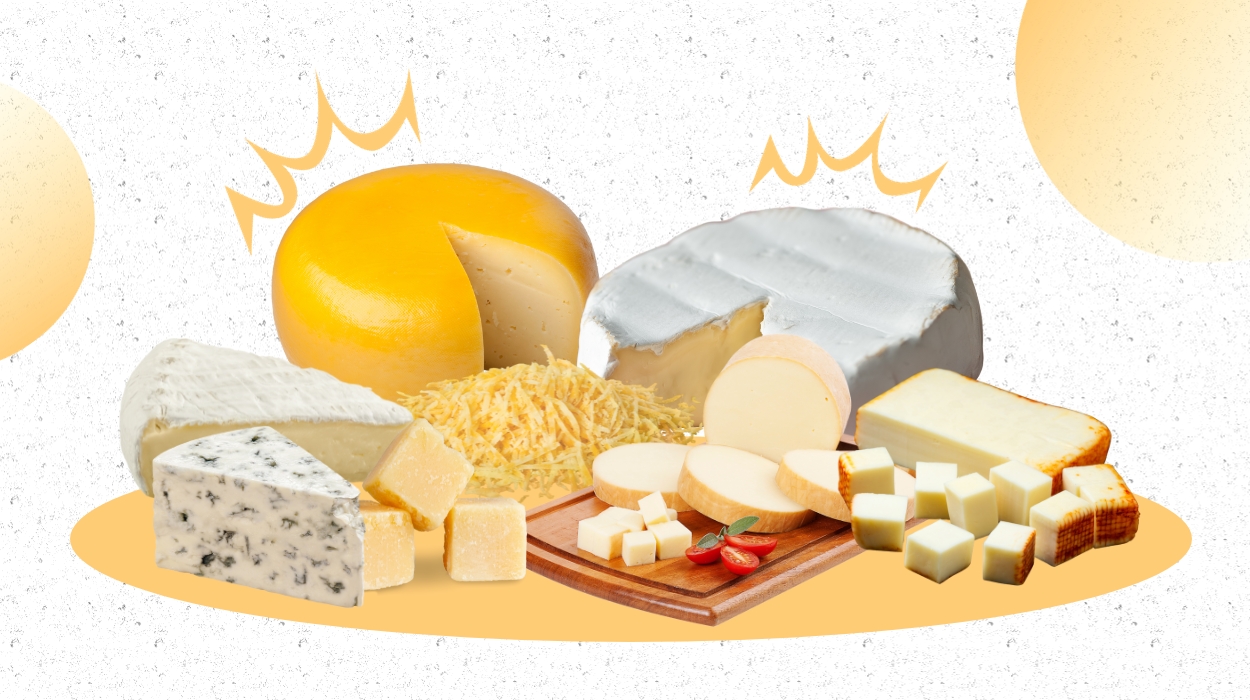 Expert's opinion
Expert's opinion
Expert's opinion
The article is a subjective view on this topic written by writers specializing in medical writing.
It may reflect on a personal journey surrounding struggles with an illness or medical condition, involve product comparisons, diet considerations, or other health-related opinions.
Although the view is entirely that of the writer, it is based on academic experiences and scientific research they have conducted; it is fact-checked by a team of degreed medical experts, and validated by sources attached to the article.
The numbers in parenthesis (1,2,3) will take you to clickable links to related scientific papers.
Low FODMAP Cheese & Consumable Amounts In 2024

Low FODMAP cheese has been linked to numerous benefits, such as higher calcium intake and possible weight loss management, particularly when combined with a low FODMAP diet. FODMAP stands for fermentable oligosaccharides, disaccharides, monosaccharides, and polyols, fermentable carbohydrates not tolerated by some with digestive diseases such as lactose intolerance or irritable bowel syndrome.
Despite the nutritional benefits, the high lactose content of some cheeses poses a risk to people with digestive disorders, such as irritable bowel syndrome. Also, most cheeses, more so creamy ones, contain significant levels of saturated fatty acids. However, they can be a good addition to a healthy diet when consumed mindfully.
But anyone with IBS or a lactose intolerance wants to know — “Is cheese low fodmap?” Luckily, many protected designations of origin, or PDO, cheeses are categorized as low fodmap, making them more tolerable to those with lactose sensitivity.[1]
So if you’re looking for low-fodmap-friendly cheeses, read on to learn which are best for you.
Low FODMAP Cheese List
Most low FODMAP cheeses are authentic, matured cheeses that age and turn lactose, a FODMAP, into lactic acid. They consist of the following:
- Camembert.
- Muenster.
- Brie
- Gouda.
- Cheddar.
- Provolone.
- Parmesan.
- Blue.
Low FODMAP Cheese
Aged cheeses have a low sugar content; the main component that causes gastrointestinal problems is lactose sugar. The low sugar content in aged cheeses is easier on the stomach. Whole milk[2] has approximately 4.81% lactose, while some cheeses, like mozzarella,[3] have less than 1% lactose.
Cheese is generally considered low FODMAP when it has less than 1 gram of lactose per serving. Most people with lactose intolerance can tolerate up to 12 grams[4] of lactose in a day.
Let’s take a closer look at low-FODMAP cheese options.
Camembert

Camembert cheese is moist, smooth, and creamy. It’s low in sugar, having only 0.13 grams[5] of carbohydrates per ounce of cheese. It has a bloomy white mold rind that gets its color from white fungus. It tastes and looks similar to Brie but contains less butterfat. It has only .o4 grams of lactose per 40-gram serving size.
Camembert cheese is hard, crumbly, and bland when fresh. Meanwhile, young Camembert cheese is sweet and creamy, developing a smooth runny interior and a rich buttery flavor as it ages.
Muenster

Is muenster cheese low fodmap? Muenster is an off-white cheese with a pale reddish paprika rind that is commonly removed even though it’s edible. It contains zero carbs.[6] The cheese has a subtle scent that grows stronger with age. Muenster is a semi-soft, nutty cheese that can be sliced and used in sandwiches.
It was created by Benedictine monks in the Alsace region of France and is named after the word monastery.
Brie
Brie is the most well-known French cheese, named after its birthplace, the Brie area of France. It contains only 0.128 grams[7] of carbohydrates per ounce of cheese. It has a smooth, creamy interior with a bloomy white edible skin. Young Brie cheese has a rigid center that melts over time. When the cheese is ripe, the surface becomes blemished, and the flavor is buttery with hints of mushroom. It has virtually no lactose content!
Brie cheese low fodmap improves with age, developing a rich flavor as the surface browns. When Brie cheese is ripe, it melts along the sliced edge. Although it was historically produced from cow milk, goat cheese variants are also available.
Gouda
Gouda is a semi-soft cow’s milk cheese. It’s made in the Netherlands and contains .629 grams[8] of carbohydrates per ounce of cheese. The cheese has a pale ivory interior with a smooth texture. When Gouda ripens, it takes on a firmer texture, a darker golden color, and a saltier flavor. It has about .2 grams of lactose per 1-cup serving, making it a low-FODMAP cheese.
Usually, hard and yellow cheeses are naturally lactose-free and can be easier to digest.
Cheddar
Cheddar cheese is the most popular type in the U.K[9] but is also loved globally. It has .415 grams[10] of carbohydrates per slice, with lactose accounting for a mere 0.027 grams. Cheddar is a sharp-tasting cow’s milk cheese. However, you can discover variations in goat, sheep, or non-dairy milk today.
Cheddar is smooth when young or properly cured and becomes sharper as it ages. Its color can range from white to yellow, but it can also be orange if colorings such as annatto are applied.
Provolone

Provolone is a semi-hard cheese made from stretched curd. It comes in various forms and sizes, such as pear, sausage, and cone. This cheese is minimal in lactose because it contains 1.0 grams[11] of carbohydrates per ounce. Provoleta and provola, two cheese variations, are available in plain or smoked varieties. Provolone is moderate fodmap cheese, with a salty flavor with nutty undertones.
Parmesan
The minimum ripening age for the Italian cheese Parmesan is one year. It’s created from cow’s milk and contains .913 grams[12] of carbohydrates for every ounce of dried cheese. The cheese has a robust nutty flavor and a complex sweet, salty, and bitter taste. It’s also firm and granular.
The rind of mature parmesan cheese is a natural straw color with a robust flavor. Other nations’ cheeses may be referred to as parmesan. However, Parmigiano Reggiano’s historical name is only used in the Italian areas where it is produced and legally protected by Italian and European law.
Blue
Bluish or greenish mold veins distinguish blue cheeses. Italian Gorgonzola, English Stilton and Blue Cheshire, French Roquefort, Bleu de Bresse, and Bleu d’Auvergne, and Danish Danablu are all popular blue cheeses. They have a low carbohydrate level of .633 grams[13] per ounce of cheese.
Most blue cheeses are manufactured with cow milk, but Roquefort uses sheep milk. Its six-month maturation process produces colorful molds with natural, irregular, or machine-made perforations. Blue cheese has a peppery flavor and can be soft, creamy, or crumbly in texture. They can have a more robust salty flavor than most cheeses but should not be bitter or overly salty.
What Is Low Lactose Cheese?
Lactose intolerance affects a significant proportion of the adult population. It can be stressful, especially if you can’t have your favorite dairy foods. Research statistics show that a whopping 68%[14] of the world’s population suffers from lactose intolerance.
The symptoms of lactose intolerance include bloating, stomach pain, flatulence, and cramping. Fortunately, certain cheeses are low in lactose, which can make them low in FODMAP. They don’t cause the usual gastrointestinal discomfort associated with lactose intolerance.
But what cheese is low FODMAP?
While young and fresh cheese contains a lot of lactose, aged cheese[15] has a lot less. The aging process converts lactose to safer lactic acid.[16] As cheese ages, lactose separates and is drained with whey.
So while probiotics and pharmaceuticals can improve gut health, choosing low FODMAP cheeses also goes a long way to help.
Here’s a comprehensive low-FODMAP cheese list:
- Camembert.
- Muenster.
- Brie
- Gouda.
- Cheddar.
- Provolone.
- Parmesan.
- Blue.
- Swiss.
- Feta Cheese.
Due to their high lactose content, lactose intolerant people should avoid soft cheeses like cream cheese. Other high FODMAP cheeses[17] include
- Velveeta.
- American Cheese.
- Cottage cheese
- Mascarpone.
- Ricotta.
Recommended Serving Size Of Low FODMAP Cheese
Sticking to a daily intake of 30 to 50 grams[18] of hard cheese can help avoid health complications. That is equal to about one to two ounces per day.
Luckily, you have many options to choose from. Low FODMAP cheeses are available in various sizes, shapes, and textures, such as cones, cylinders, and string cheese. They also vary in lactose content, color, texture, and flavor. In a study of 25 PDO cheeses, the majority had less than 10 mg/kg lactose[19] concentration.
However, low FODMAP cheese can still lead to bloating and weight gain if ingested in excess.
Cheese, Weight Loss, And IBS
Many people look for the most effective weight loss solutions available today, including their favorite foods. But, the best way to manage your weight while living with IBS or any form of lactose intolerance is to monitor your overall intake of fermentable carbohydrates by including foods with low FODMAP content.
Also, remember that a dairy-free diet doesn’t guarantee weight loss or fewer IBS symptoms. But if you love cheese, observing your reactions to small portions can be part of a balanced low FODMAP diet. Of course, you must also consider other healthy low-FODMAP foods, like certain fruits, vegetables, nuts, and seeds.
Finally, if IBS symptoms still exist after switching to a low FODMAP meal plan, you can try supplements for digestion to see if they help. Digestive enzymes, i.e., lactase, may help break down the lactose sugar so it does not create symptoms in those sensitive to it.
Final Thought
Cheese is loved by many and goes well with many dishes, but the high lactose level in some cheese and cheese products can cause bloating, cramps, constipation, and gas. Fortunately, a balanced diet with specific low-FODMAP cheese types can help with IBS symptoms.
Many authentic ripened cheeses, such as muenster, cheddar, blue, brie, gouda, and camembert, contain low levels of lactose. This can effectively prevent stomach discomfort.
Ultimately, gluten and lactose consumption is still being studied as an intervention for such symptoms. Recent research indicates that a low FODMAP diet can considerably alleviate symptoms of lactose intolerance [20] and IBS.
While the original cheeses listed above are designated low FODMAP, the production method of their imitations differs and may not be low FODMAP.
Frequently Asked Questions
Camembert, Muenster, Brie, Gouda, Cheddar, Provolone, Parmesan, and Blue are low-FODMAP cheeses.
Mozzarella cheese contains somewhat more lactose than the other cheeses on our list, but it is safe to eat in small amounts.
Since lactose is converted to lactic acid during aging, most PDO cheeses are low FODMAP due to the technology used in processing these cheeses using only raw milk, rennet, and lactic acid bacteria.
Swiss cheese is low in FODMAP since each serving contains less than 1 gram of carbs.
+ 18 sources
Health Canal avoids using tertiary references. We have strict sourcing guidelines and rely on peer-reviewed studies, academic researches from medical associations and institutions. To ensure the accuracy of articles in Health Canal, you can read more about the editorial process here
- https://www.ncbi.nlm.nih.gov/pmc/articles/PMC8464992/#:~:text=The%20analytical%20techniques%20used%20here%20for%20lactose%20determination,in%20a%20lactose%20content%20less%20than%20the%20LOQ.
- Usda.gov. (2023). FoodData Central. [online] Available at: https://fdc.nal.usda.gov/fdc-app.html#/food-details/746782/nutrients.
- Usda.gov. (2023). FoodData Central. [online] Available at: https://fdc.nal.usda.gov/fdc-app.html#/food-details/329370/nutrients.
- https://www.niddk.nih.gov/health-information/digestive-diseases/lactose-intolerance/eating-diet-nutrition
- Usda.gov. (2023). FoodData Central. [online] Available at: https://fdc.nal.usda.gov/fdc-app.html#/food-details/172178/nutrients.
- Usda.gov. (2023). FoodData Central. [online] Available at: https://fdc.nal.usda.gov/fdc-app.html#/food-details/502867/nutrients.
- Usda.gov. (2023). FoodData Central. [online] Available at: https://fdc.nal.usda.gov/fdc-app.html#/food-details/172177/nutrients.
- Usda.gov. (2023). FoodData Central. [online] Available at: https://fdc.nal.usda.gov/fdc-app.html#/food-details/171241/nutrients.
- Hashem, K.M., He, F., Jenner, K.H. and MacGregor, G.A. (2014). Cross-sectional survey of salt content in cheese: a major contributor to salt intake in the UK. [online] 4(8), pp.e005051–e005051. doi:https://doi.org/10.1136/bmjopen-2014-005051.
- Usda.gov. (2023). FoodData Central. [online] Available at: https://fdc.nal.usda.gov/fdc-app.html#/food-details/328637/nutrients.
- Usda.gov. (2023). FoodData Central. [online] Available at: https://fdc.nal.usda.gov/fdc-app.html#/food-details/470808/nutrients.
- Usda.gov. (2023). FoodData Central. [online] Available at: https://fdc.nal.usda.gov/fdc-app.html#/food-details/170848/nutrients.
- Usda.gov. (2023). FoodData Central. [online] Available at: https://fdc.nal.usda.gov/fdc-app.html#/food-details/172175/nutrients.
- https://www.niddk.nih.gov/health-information/digestive-diseases/lactose-intolerance/definition-facts#common
- Crupi, R., Vincenzo Lo Turco, Enrico Gugliandolo, Nava, V., Hedi Ben Mansour, Cuzzocrea, S., Giuseppa Di Bella and Licata, P. (2022). Mineral Composition in Delactosed Dairy Products: Quality and Safety Status. [online] 11(2), pp.139–139. doi:https://doi.org/10.3390/foods11020139.
- Santarcangelo, C., Baldi, A., Ciampaglia, R., Dacrema, M., Alessandro Di Minno, Pizzamiglio, V., Gian Carlo Tenore and Daglia, M. (2022). Long-Aged Parmigiano Reggiano PDO: Trace Element Determination Targeted to Health. [online] 11(2), pp.172–172. doi:https://doi.org/10.3390/foods11020172.
- Fedewa, A. and Satish S.C. Rao (2013). Dietary Fructose Intolerance, Fructan Intolerance and FODMAPs. [online] 16(1). doi:https://doi.org/10.1007/s11894-013-0370-0.
- Cozma-Petruţ, A., Loghin, F., Doina Miere and Dumitrascu, D.L. (2017). Diet in irritable bowel syndrome: What to recommend, not what to forbid to patients! [online] 23(21), pp.3771–3771. doi:https://doi.org/10.3748/wjg.v23.i21.3771.
- Maria Sole Facioni, Dominici, S., Marescotti F, Covucci, R., Taglieri, I., Venturi, F. and Zinnai, A. (2021). Lactose Residual Content in PDO Cheeses: Novel Inclusions for Consumers with Lactose Intolerance. [online] 10(9), pp.2236–2236. doi:https://doi.org/10.3390/foods10092236.
- https://pubmed.ncbi.nlm.nih.gov/28233394/



